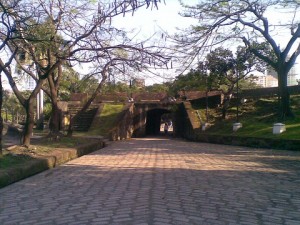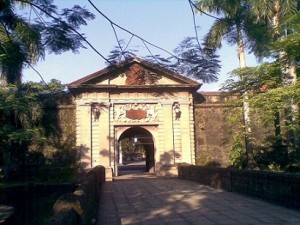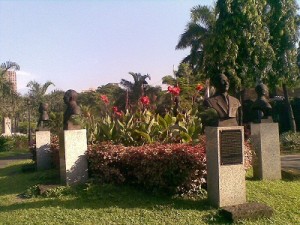By YOLANDA L. PUNSALAN
 POCKETS of spur-of-the moment vacations on a miniscule budget, covering only jeep or bus fare and the occasional street food snacks, can be had by anyone nimble enough to enjoy the Walled City of Intramuros while imbibing history.
POCKETS of spur-of-the moment vacations on a miniscule budget, covering only jeep or bus fare and the occasional street food snacks, can be had by anyone nimble enough to enjoy the Walled City of Intramuros while imbibing history.![]()
One can devise his own personal walking tour, starting on Muralla Street in Intramuros.
Amid the clip-clopping of horses’ hoofs handled by Filipiniana-attired carriage men who also double as tourist guides, the Baluarte de San Andres beckons, rising a few meters above the street, and overlooks the Intramuros Golf Course.
The Baluarte, also known as Carranza, is a reminder of the engineering feat of the Spanish regime, giving a picture of how the soldiers defended the Governor General by setting up 20 cannons atop it. The structure includes a bomb-proof arsenal for gunpowder and a garita (watchtower).
Built in 1603, it was designed to protect the old Puerta Real and reinforce the southeastern part of Intramuros. Also known by its other name, Baluarte de San Nicolas, it was destroyed in 1762 during the British siege, and completely damaged during the 1945 Battle of Manila. The beauty that can be enjoyed now is the result of restoration works in 1987.
One is advised though to beware of flying golf balls as one walks this historical path.
The whole stretch of the walk gives one a mid-air tour of the academic institutions surrounding it. There is the Mapua Institute of Technology, now owned by the Yuchengcos. Beside it is a circular, gated chapel of the Third Order of the Franciscans. However, it doesn’t look like it functions as a place of worship any longer. The Lyceum of the Philippines of the Laurels looks sleek and newly refurbished.
 Adding to the European ambience is a multi-storey hotel-looking edifice called The Bayleaf. Its cool and appealing appearance reminiscent of a Swiss chalet.
Adding to the European ambience is a multi-storey hotel-looking edifice called The Bayleaf. Its cool and appealing appearance reminiscent of a Swiss chalet.
At the farthest end is the oldest structure, the Colegio de San Juan de Letran, proudly displaying its birth year at some sixteenth century date. It is festooned with congratulatory tarpaulins hailing Archbishop Chito Tagle.
Beneath the walls, one will come upon the Asean Garden. Well-manicured with all varieties of foliage and flora, and also protected by cannons at the parapet facing the City Hall of Manila, this landscape has the bas relief of the Asean Declaration of Independence signed by the five original foreign ministers on August 1, 1967. Our Philippine front liner was Narciso Ramos, father of our past president Fidel V. Ramos. One may be puzzled to see a very new, sparkling, almost golden bust of Ho Chi Minh! He seems so solitary in that one section of the garden. Some updating has to be done, too, for now, the Asean already has 10 members, and only the five original nations are represented there.
The Asean Garden has two entrances. If one comes from the Jones Bridge, he can get off immediately on the bridge landing, and enter a nondescript gate leading to the garden. The more imposing entrance is the one fronting the Lyceum of the Philippines. This particular spot is called the Puerta del Parian and Ravellin del Parian, named after the Parian de Arroceros, across the city where the Chinese merchants lived and plied their trades.
 Further skips and gaits bring one to the most popular and cheapest relaxation venue for any Pinoy—-(remember Rico J. singing “mamasyal sa Luneta ng walang pera”)—-the Luneta, or Rizal Park. Thousands of kids, parents, teenagers, and seniors, well-dressed and casually dressed, can get mesmerized by the dancing fountains cavorting to the upbeat pop tunes. Fiery blasts in between stanzas thrill promenaders as the mid-day winds sprinkle the fountain waters on the warm bodies standing along the perimeter.
Further skips and gaits bring one to the most popular and cheapest relaxation venue for any Pinoy—-(remember Rico J. singing “mamasyal sa Luneta ng walang pera”)—-the Luneta, or Rizal Park. Thousands of kids, parents, teenagers, and seniors, well-dressed and casually dressed, can get mesmerized by the dancing fountains cavorting to the upbeat pop tunes. Fiery blasts in between stanzas thrill promenaders as the mid-day winds sprinkle the fountain waters on the warm bodies standing along the perimeter.
Flights of doves playfully hover. Multi-colored tents are personally brought by those better off, and serve as their lunch pad under the summer heat. For those without temporary shelters, there are enterprising vendors who sell huge mats, looking like thick aluminum foils, for them to spread on the grass and use as their picnic blankets.
Meanwhile, elegant horse drawn carriages ferry passengers around the park. One is a replica of the same tourist attraction train in chilly San Francisco.
Leave it to us Pinoys to enjoy any given summer day on a shoestring budget. On weekends this whole month of April, the Italian Embassy is showing free Italian films at the Rizal Park open air theater. Thoughtful administrators of the park have put up a schedule of their activities for April, including cultural dances and a rock stars’ performance to cap this warm month.